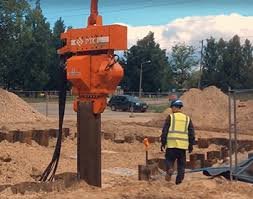Vibratory Hammers are powerful tools widely used in construction for driving or extracting piles from the ground. They use vibration to reduce soil resistance, allowing piles to be inserted or removed more easily. These machines save time and reduce the effort needed compared to traditional pile driving methods.
However, as with any heavy equipment, proper operation and safety practices are essential. If used incorrectly, Vibratory Hammers can cause serious accidents, damage to equipment, or harm to workers. This guide will help beginners understand what Vibratory Hammers are, how they work, and the safest way to operate them.
Understanding Vibratory Hammers
Before you start working with Vibratory Hammers, you need to know what they do and how they function.
A Vibratory Hammer works by producing vertical vibrations through a hydraulic or electric motor. These vibrations loosen the soil around a pile, making it easier to push it into the ground or pull it out. Unlike impact hammers, they do not rely on heavy blows but instead on continuous vibration.
Common Uses of Vibratory Hammers:
-
Driving steel sheet piles for retaining walls
-
Installing foundation piles for bridges or buildings
-
Extracting old piles from the ground
-
Working in both land-based and marine construction projects
Why Safety is Important When Using Vibratory Hammers
Vibratory Hammers are powerful and heavy. They operate with strong vibrations and high energy levels, which can be dangerous if not controlled properly. Safe operation is not just about protecting the operator; it also keeps the entire worksite safe.
Some possible risks include:
-
Injury from moving parts
-
Falling objects during pile lifting or driving
-
Damage to surrounding structures from excessive vibration
-
Electrical or hydraulic hazards
Following safety guidelines reduces these risks and ensures the job is completed efficiently without delays.
Pre-Operation Safety Checks
Before starting any work with Vibratory Hammers, you should carry out a thorough inspection.
1. Inspect the Equipment
Check for visible damage, loose bolts, oil leaks, or worn-out parts. Ensure that hydraulic hoses and cables are in good condition.
2. Test the Controls
Make sure the start, stop, and emergency controls are functioning properly.
3. Secure the Pile
Before starting the hammer, confirm that the pile is held firmly by the clamp or grip of the Vibratory Hammer.
4. Wear the Right Safety Gear
Always wear a helmet, safety goggles, gloves, steel-toe boots, and hearing protection. Vibratory Hammers are loud, so ear protection is important.
Step-by-Step Safe Operation of Vibratory Hammers
Here’s a simple and safe way to operate Vibratory Hammers, especially if you are new to them.
Step 1: Position the Pile Correctly
The pile must be positioned vertically and aligned with the desired location. A misaligned pile can cause accidents and affect the stability of the structure.
Step 2: Attach the Vibratory Hammer Securely
Use the lifting equipment to connect the Vibratory Hammer to the pile. Make sure the clamp is tight and secure before starting.
Step 3: Start the Hammer Slowly
Engage the vibrations gradually. Avoid starting at full power immediately to prevent sudden movements.
Step 4: Guide the Pile Smoothly
Allow the vibrations to loosen the soil, and let the pile sink naturally with minimal force from the crane or rig.
Step 5: Monitor the Process
Watch for signs of misalignment or resistance. If the pile stops moving, stop the hammer, reposition, and continue.
Step 6: Stop and Secure
Once the pile is in position, stop the Vibratory Hammer completely before detaching it.
Extra Safety Tips for Beginners
-
Stay Clear of Moving Parts – Never stand near the clamp or under the hammer during operation.
-
Avoid Over-Vibration – Excessive vibration can damage both the pile and surrounding structures.
-
Communicate Clearly – Operators and ground workers should use agreed hand signals or radios to coordinate actions.
-
Work in Stable Conditions – Avoid operating in strong winds or unstable soil without extra precautions.
-
Know the Load Limits – Do not use the Vibratory Hammer for piles that exceed the manufacturer’s weight or size limits.
Maintenance for Safe Operation
Proper maintenance keeps Vibratory Hammers safe and efficient. After each use:
-
Clean dirt and debris from the equipment
-
Check oil and hydraulic fluid levels
-
Inspect clamps for wear and tear
-
Store in a dry, secure place
Regular servicing by trained technicians will extend the life of your Vibratory Hammers and prevent unexpected breakdowns.
Training is the Key to Safety
Even though Vibratory Hammers are designed for efficiency, they require skill to operate safely. New operators should receive proper training on:
-
Understanding equipment controls
-
Recognizing hazards
-
Following safety procedures
-
Emergency shutdown steps
The more familiar you are with the equipment, the safer and more productive your work will be.
Conclusion
Vibratory Hammers are essential tools in modern construction, offering speed and efficiency in pile driving and extraction. However, their power comes with responsibility. By following safety checks, wearing protective gear, operating step-by-step, and keeping the equipment well-maintained, even beginners can handle Vibratory Hammers with confidence.
